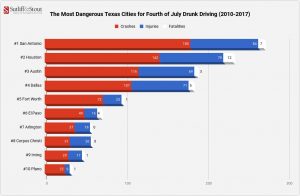Happy Fourth of July! As we roll into the weekend, let’s keep in mind the importance of this holiday.
The lingering presence of the Coronavirus is overwhelming. We thought it would be over by now. We were told that months of ‘shelter-in-place’ restrictions would flatten the curve for good. And that preventative practices, like gloves and masks, would slow the spread of the virus. Now, we are seeing the number of positive cases on the rise.

So, how do we celebrate “Independence Day” while still respecting these abnormal government recommendations?
Just keep rolling.
Some people will be sitting this holiday out. You may not get to attend a family BBQ or head out to the lake for the long weekend. It definitely won’t be your typical 4th of July. The most important thing, as always, is your safety.
Watch out for these top hazards during this unique holiday weekend.
Hazards
Crowded Highways
While the unique circumstances of 2020 make it difficult to predict traffic patterns, Independence Day usually shows a massive increase in highway traffic. In addition, air traffic has slowed significantly in the last few months, meaning travelers are more likely to hit the highway.

Highway Closures
With road construction in full swing, it is likely you will run into some lane closures and detours. These closures added to the increased holiday traffic could be disastrous. Expect the unexpected but be prepared.
Unusual amounts of summer rain have closed some smaller back roads. Always check local conditions before you leave the main highway.
The Federal Highway Administration offers a resource tool regarding national traffic and road closure information. Use this tool during your pre-trip to avoid adverse weather, bad road conditions, and highway closures.

Protesters
In the last few weeks, we have seen people gathered on highways and bridges as demonstrators. They are stopping traffic to gain a larger impact.
While there has been a decrease lately in the number of protests, the upcoming 3-day weekend gives plenty of opportunity for another round. Stay up to date on the news to determine if delays are possible within your route.

Fireworks Displays
Commercialized fireworks displays, previously a longstanding tradition, are being canceled all over the country for social distancing.
People still want to celebrate, so they are bringing the show to their neighborhoods. Across the country, fireworks sellers are reporting sales of up to 200% over this time last year.
“We’ve had a lot of new customers coming in. People want to get out of the house: They want to celebrate.”
–Greg Spencer, Store Manager, Big Bang Boom (fireworks store)
If you happen to see a fireworks show lighting up the night sky, proceed with caution. Stop to enjoy it if you’d like, but please, find the nearest safe haven. You can take that time to celebrate the holiday and take your DOT break.

Distracted Drivers
Don’t expect to see a huge fireworks display in localized areas. Instead, you will likely experience small, spread out shows from private properties.
Keep in mind, others on the road will be distracted by the same things. Every flash, bang, and “oooh, ahhh,” is a moment that a driver’s eyes are off the road. Watch for signs that a driver is distracted on the highway.
Signs a driver may be distracted:
- – Frequent, Quick Corrections
- – Lane Drifting
- – Oversteering
- – Varying Rate of Speed
- – Last Second Braking
- – Checking the Rumble Strips
- – Holding a Cell Phone
- – Eating/Drinking
- – Tending to Children
- – Dancing

Drunk Drivers
The Sutliff and Stout Law Firm conducted a traffic data analysis regarding the Fourth of July patterns. Their results show an increase in drunk driving all over the state of Texas. In one city, drunk driving occurrences increased as much as 90% over normal rates.
The increase in drunk driving correlates with a 28% increase in crashes and a 34% increase in fatalities.
Another chart shows the cities where an accident involving a drunk driver is most likely to occur. Most of these cities are major hubs for trucking activity. While preplanning, look out for major cities and plan accordingly. Stay off the roads if you can, at least for the night.
Speeding
CVSA’s Safe Driver Week is coming up. Law Enforcement Officers will be gearing up for a weeklong blitz, this year focused on speeding.
Speed has been a common denominator in more than 25% of CMV crash fatalities since 2008, according to the Highway Loss Data Institute.
Last year, commercial motor vehicle drivers were issued 1,454 speeding tickets and 2,126 speed warnings during Safe Driver Week. Speeding was the top issued citation and warning category for CMVs and personal vehicles alike.

Above all, keep your drivers, and yourself, safe out there. We have been faced with many unknowns throughout the pandemic. Each new crisis brings even more unforeseen challenges.
The trucking industry quickly adapts to changes, we always have. Keep your eyes open, put down your phone, get out and look, and always drive safely.
Enjoy your 4th!
Keep on Reading:
Why A Positive Dispatcher & Driver Relationship is Key
5 Intangible Must Haves that Truckers Crave in the Job Market
Truck Drivers Challenged by Demonstrations All Over the Country
Minimize Mistakes to Maximize your Most Valuable Resource – Your Drivers

































































